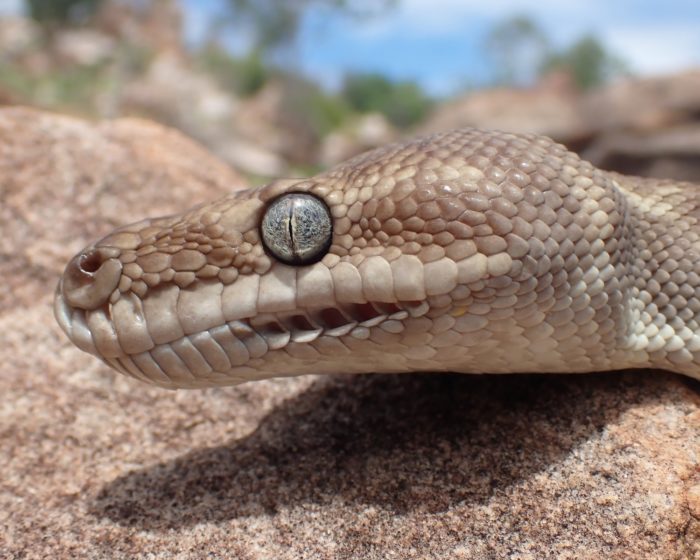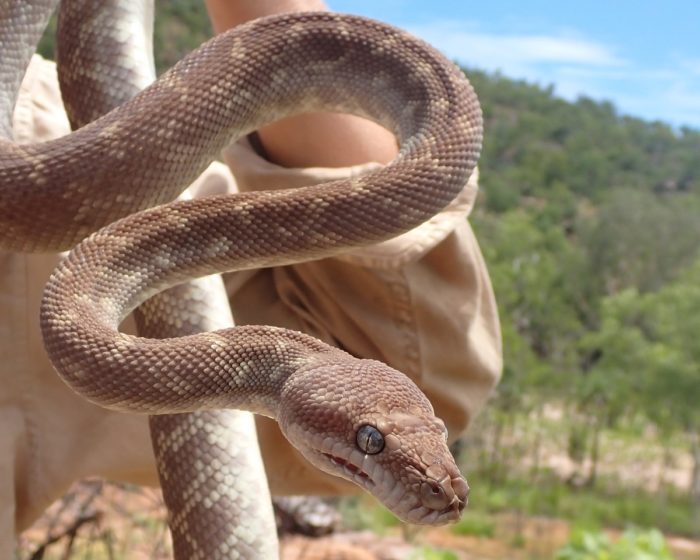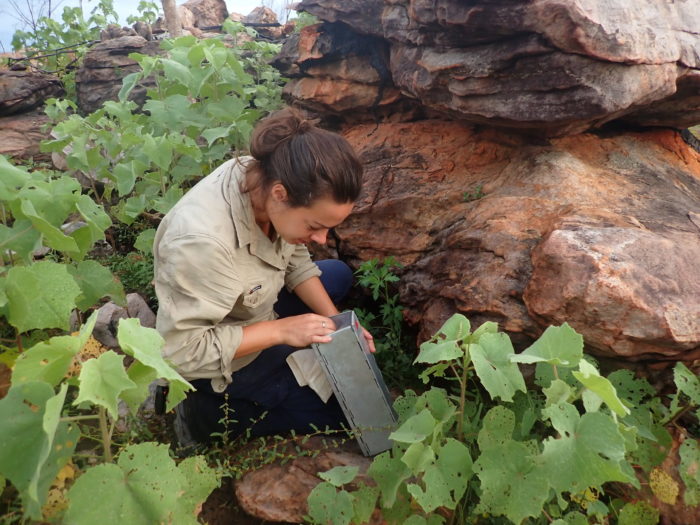Australian Wildlife Conservancy (AWC) ecologists have recorded one of the country’s rarest reptiles at Charnley River-Artesian Range Wildlife Sanctuary during recent biodiversity surveys at the remote Kimberley site.
The discovery of an elusive Rough-scaled Python (Morelia carinata) topped off a successful round of trapping, spotlighting and other surveys, during which the team encountered many of the region’s unique and threatened species; including Black Grasswrens (Amytornis housei), Northern Quolls (Dasyurus hallucatus), and Golden-backed Tree-rats (Mesembriomys macrurus).
Rough-scaled Python finding
 L Potter/AWC
L Potter/AWC
Not much is known about the wild habits of Rough-scaled pythons, and only a handful of wild sightings have been recorded to date.
This one was spotted on the last day of the survey by Field Ecologist Joe Porter, who saw the snake from a distance while trying to locate a survey trap.
“As we were looking into the distance to locate on of our other traps I saw some eye shine up on a rock and looked over at Skye (Skye Cameron, Regional Ecologist) and said ‘oh, that looks like a big snake’ ”, says Joe.
“As we got a little bit closer I realised it was a Rough-scaled Python, a really unique and rarely seen snake up in the Kimberley. So we approached it and got a genetic sample. It was pretty amazing to see it in that landscape, and to actually feel the rough scales and see it in the flesh.”
The python was in good health. It measured about 1.6metres, which is a decent length for the species which can grow to two metres. Each scale has a keel or ridge running along its centre which gives it a rough, sandpaper-like feel hence the common name of Rough-scaled Python. It uses these specially adapted scales to climb sandstone escarpments and trees in the region.
Joe recently explained his experience to ABC Radio Kimberley – listen to it here
 L Potter/AWC
L Potter/AWC
Charnley River-Artesian Range biodiversity surveys
Following several years of below-average rainfall, the bumper 2020/21 wet season in Australia’s north has reinvigorated the landscape and is providing a much-needed boost to wildlife populations.
Located in the only part of mainland Australia to have suffered no wildlife extinctions, the Artesian Range is a rugged, complex landscape, inaccessible by road.
Using AWC’s remote David Attenborough Field Research Station as their base, the team was deployed by helicopter to each of their field sites, along with camping gear, food supplies, and trapping equipment.
The ecologists worked around the clock to make the most of valuable time on the ground, conducting nine separate surveys concurrently over two 12-day expeditions.
 B Riles/AWC
B Riles/AWC
The team used a mix of motion-sensor cameras and live traps to target mammals, heading out before dawn each day to identify, process and release animals caught during the night.
After sundown, they spent a total of more than thirty hours doing spotlighting surveys to search for rare and endangered nocturnal animals like Monjon (Australia’s smallest rock-wallaby, Petrogale burbidgei) and Wyulda (Scaly-tailed Possum, Wyulda squamicaudata), as well as the diversity of geckos living among the rocky escarpments and jumbled boulders.
They also ran transect surveys for Black Grasswrens (Amytornis housei) and deployed audiomoths (audio recording devices) to detect frog calls.
 K Lowe and J Porter/AWC
K Lowe and J Porter/AWC
The recent round of surveys at Charnley River-Artesian Range will contribute to AWC’s Ecohealth monitoring program, designed to track important indicators of ecological health over time. This field ecology program is the largest in the country, with over 250,000 trap nights conducted every year across 6.5 million hectares around Australia. The program is vital for measuring the status of biodiversity on each site and the impact of our conservation actions on wildlife.
Learn more:
Senior Field Ecologist Larissa Potter and Field Ecologist Joe Porter spoke to Joey Clarke about the exciting discoveries at Artesian Range in a season 4 episode of AWC in Conversation webinar. If you missed it, catch up now here:
Please help us conduct vital biodiversity monitoring in this remote area of Australia
Donate now